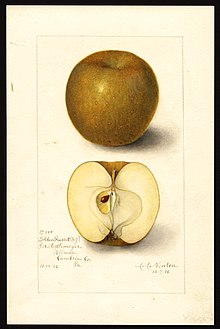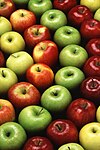
Cox's Orange Pippin, in Britain often referred to simply as Cox, is an apple cultivar first grown in 1825, at Colnbrook in Buckinghamshire, England, by the retired brewer and horticulturist Richard Cox. Though the parentage of the cultivar is unknown, Ribston Pippin seems a likely candidate. DNA analysis of major apple pedigrees has suggested Margil as the parent of Cox, with Ribston Pippin being another Margil seedling. The variety was introduced for sale by the 1850s by Charles Turner, and grown commercially from the 1860s, particularly in the Vale of Evesham in Worcestershire, and later in Kent.

A cooking apple or culinary apple is an apple that is used primarily for cooking, as opposed to a dessert apple, which is eaten raw. Cooking apples are generally larger, and can be tarter than dessert varieties. Some varieties have a firm flesh that does not break down much when cooked. Culinary varieties with a high acid content produce froth when cooked, which is desirable for some recipes. Britain grows a large range of apples specifically for cooking. Worldwide, dual-purpose varieties are more widely grown.

The 'Roxbury Russet' is an apple cultivar, believed to be the oldest apple cultivar bred in the United States, having first been discovered and named in the mid-17th century in the former Town of Roxbury, part of the Massachusetts Bay Colony southwest of Boston. It is known by several other names including 'Boston Russet', 'Putnam Russet', and 'Sylvan Russet'.

'Ribston Pippin' is a triploid cultivar of apples, also known by other names including 'Essex Pippin', 'Beautiful Pippin', 'Formosa', 'Glory of York', 'Ribstone', 'Rockhill's Russet', 'Travers', and 'Travers's Reinette'.

A pearmain, also formerly spelt "permain", is a type of apple. The name may once have been applied to a particular variety of apple that kept well, although in more modern times its inclusion in varietal names was, like the term 'Pippin', "largely decoration" rather than indicating any shared qualities.

Claygate Pearmain is an apple cultivar. It was found at Claygate, Surrey in England and brought to the attention of the Royal Horticultural Society by John Braddick in 1821. The apple was a popular eating apple in Victorian times and spread through England and to America.
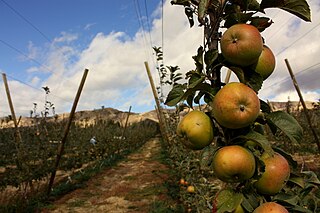
The Newtown Pippin, also known as Albemarle Pippin, is an American apple that originated in the late 17th or early 18th century and is still cultivated on a small scale. At one time, there were two very similar apple cultivars known as the 'Yellow Newtown' and 'Green Newtown', one of which perhaps originated as a sport of the other.

Rajka is a hybrid cultivar of domesticated apple from the Czech Republic, specifically for eating. Rajka was crossed and developed by the Institute of Experimental Botany from the Champion and Katka apples for scab resistance, hence possible to grow organic.

Anna apple is a dual purpose cultivar of domesticated apple that is very early ripening and does well in warm climates.

'Akane', also known as 'Tokyo Rose', 'Tohoku No.3' and 'Prime Red', is a Japanese cultivar of domesticated apple, that according to Orange Pippin is one of the best early season apples.

'Allington Pippin' is an English cultivar of domesticated apple, with a strong flavour that includes hints of pineapple.

Fiesta is a modern cultivar of domesticated apple which is often marketed as Red Pippin. It was developed in the United Kingdom by breeders at the East Malling Research Station, combining the Cox's Orange Pippin with the Idared apple. According to the Orange Pippin website, it is one of the best Cox's style apples, but much easier to grow having good disease resistance.

'Dorsett Golden' is a 'Golden Delicious'-like cultivar of domesticated apple and is descended from it, but is different with that it is early season, and most importantly, it needs a lower amount of cold weather to go into blooming, so it is possible to grow in warm climates.

Reinette du Canada or Canadian Reinette is, despite its name, an old French cultivar of domesticated apple. It is a reinette type of golden apple, with much russeting, which keeps shape in cooking and is mainly used for that purpose especially in apple strudel.

Suntan is an English cultivar of domesticated apple that have earned the Award of Garden Merit by the Royal Horticultural Society in 1999.
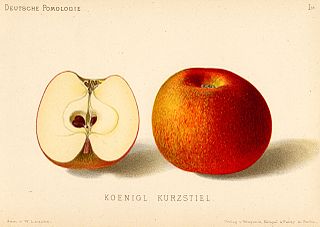
Court Pendu Plat is an extremely old French cultivar of domesticated apple that was first recorded in 1613. The cultivar definitely dates back to earlier than the 17th century, and was probably cultivated by the Romans. It is known for its intense flavor which mellows with storage.

Red Astrachan is a Russian or Swedish cultivar of domesticated apple, which is an early season apple, juicy, tart and mealy texture with pleasant flavour, and use for eating, cooking and cider. It is medium-sized, crimson colored. As all the early season apples, it is not good for storage. It is known by several other names including 'Abe Lincoln', 'American Red', and 'Waterloo'.

Flamenco, also known as Ballerina Obelisk, is a cultivar of domesticated apple that bears apples good for eating fresh, and is grown for its unusual ornamental properties. The tree grows in a straight up columnar style, with many small fruit-bearing branches. 'Flamenco' is one of a series of apple tree cultivars that share a registered trademark under the name Ballerina.
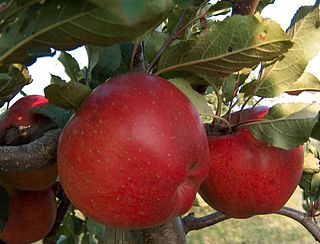
Melrose is a modern cultivar of domesticated apple which was developed by Freeman S. Howlett at the Ohio Agricultural Experiment Station in Ohio, United States, and is regarded as the official apple of that state.

Grenadier is an English cultivar of domesticated apple mainly used for cooking. It originated in the mid-19th century in Buckinghamshire. It was first recorded in 1862 in Maidstone, Kent, exhibited by Charles Turner of Slough, Berkshire, and then commercially introduced by Bunyard Nursery.
